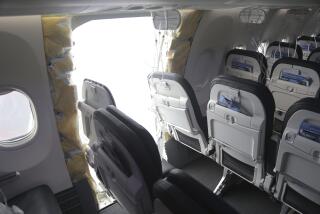Boeing CEO no stranger to crisis as 787 tragedy poses new test

- Share via
Boeing Co. Chief Executive Kelly Ortberg finds himself in a familiar role — facing another crisis — this time a crash involving the company’s marquee 787 Dreamliner jet in India that killed more than 240 people.
In his first nine months as CEO, Ortberg had led the company through the early signs of a turnaround. He navigated a cash crunch, rising labor unrest, a rush to overhaul the company’s safety operations, and a trade war wrought by President Trump against one of Boeing’s biggest customers: China.
But just as Ortberg seemed to be gaining momentum and earning cautious praise for the discipline and rigor he brought to the long-troubled company, a horrifying crash of an Air India 787 bound for London served as a reminder of how hard it is to win back confidence in the plane maker.
Boeing stock dropped nearly 5% Wednesday on the news of the accident, which killed 241 of the 242 people on board, once again associating the plane maker with safety concerns.
“It’s a classic moment of crisis management and fast response: getting out there and sending teams to understand what happened, and just being there to reassure people,” said aerospace consultant Richard Aboulafia. “A lot of life is just showing up.”
In a statement, Ortberg expressed his condolences to the families of the passengers and crew on board and the people of Ahmedabad, where the flight originated. He also offered Air India support in the crash investigation.
Meanwhile, questions arose as to whether Ortberg and the Boeing team would still go through with the company’s plans for the Paris Air Show, which would serve as an opportunity for the CEO to showcase the company’s progress and book additional plane orders.
The company hasn’t said whether Ortberg will attend the trade expo, which begins Monday, and aim to avoid the appearance of focusing on driving sales at a time when the crash’s victims are still being pulled out of the rubble.
It could take weeks, or even months, to discover the cause of the crash, and how Ortberg responds during this time will be closely watched.
This crash risks overshadowing Paris and limiting Boeing’s involvement in the aviation industry’s largest event, Ken Herbert of RBC Capital Markets said in a note to clients.
So far, experts say the video footage seems to point to a loss of power — whether from a bird strike, contaminated fuel, maintenance or pilot error, or some other factor. They say it’s less likely the crash was related to the design and build of the aircraft itself, which has been flying for Air India for 11 years.
Even still, for Boeing executives “it’s going to be a very tense 24 hours,” Aboulafia said.
Ortberg, a low-key Midwesterner and engineer by training, came out of retirement last year to take on one of the tougher turnarounds in corporate America. Boeing was reeling from a near-catastrophe on an airborne 737 Max that spurred investigations, a crackdown by U.S. regulators and a leadership exodus.
He’s kept a low public profile while preaching internally the importance of instilling a culture that emphasizes civility, respect and pride in workmanship. A working group of employees, formed to craft a statement of values, insisted on urging Boeing’s workforce to “give a damn.”
Boeing customers like John Plueger, the chief executive of Air Lease, the largest U.S. aircraft financier, have noticed a difference. The manufacturer’s planes are arriving on time, Plueger said in an interview last month. The company’s jet factories and supply chain seem to be moving with few glitches and disruptions, although they’re still a concern, he said.
The U.S. plane maker even enjoyed the momentum of a record order placed by Qatar Airways during a visit by Trump, which propelled its May orders to the highest such tally in about 18 months.
That momentum risks stalling as the company works to find out what role, if any, Boeing played in the plane crash.
The plane at the center of the tragedy was built during the early days of the 787 program, when Boeing was struggling with the consequences of a decision to off-load much of the design and development work to suppliers in order to cut costs. The Dreamliner was the 26th to roll off Boeing’s line, placing it among the 60 early aircraft that required extensive rework after they’d left Boeing’s factory north of Seattle.
The early turbulence of the 787 Dreamliner had faded as the carbon-composite jet settled into a mostly steady performer for carriers from ANA to United Airlines.
While Plueger has confidence in the company’s leadership, “Boeing is not completely out of the woods,” he said. “It needs to consistently deliver and consistently demonstrate high-quality production with no real glitches or problems or safety concerns.”
Johnsson writes for Bloomberg.
More to Read
Inside the business of entertainment
The Wide Shot brings you news, analysis and insights on everything from streaming wars to production — and what it all means for the future.
You may occasionally receive promotional content from the Los Angeles Times.










